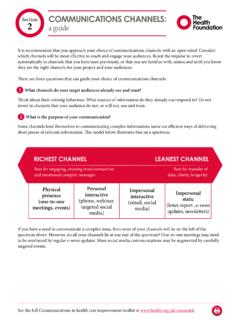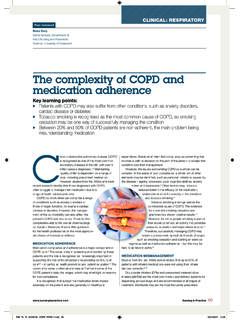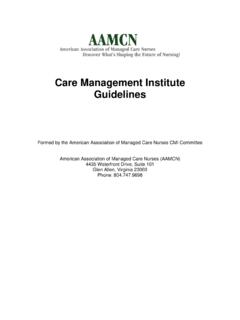Transcription of Briefing: Understanding the health care needs of people ...
1 BriefingNovember 2018 Briefing: Understanding the health care needs of people with multiple health conditionsMai Stafford, Adam Steventon, Ruth Thorlby, Rebecca Fisher, Catherine Turton and Sarah DeenyKey points As the number of people with multiple health conditions grows, meeting their needs will be one of the biggest challenges facing the NHS. In 2006/07, one in 10 patients admitted to hospital as an emergency had 5+ conditions. In 2015/16, the figure was one in three. people with multiple conditions often have poorer quality of life, greater risk of premature death, and may need substantial NHS support. But the ability of the NHS to plan care that responds to these needs has been hampered by a lack of information about the conditions that people have and their existing patterns of care.
2 To fill some of the gaps, we analysed data from 2014 to 2016 for 300,000 people in England. We considered 36 health conditions, including physical and mental health conditions, ongoing symptoms such as chronic pain, sensory impairment and substance misuse. We found that one in four adults had 2+ health conditions. This equates to approximately million people in England with multiple conditions. people in disadvantaged areas are at greater risk of having multiple conditions, and are likely to have multiple conditions at younger ages. Around 28% of people in the most-deprived fifth of England have 4+ conditions, compared with 16% in the least-deprived fifth. In the least-deprived fifth of areas, people can expect to have 2+ conditions by the time they are 71 years old, but in the most-deprived fifth, people reach the same level of illness a decade earlier, at 61 years of : Understanding the health care needs of people with multiple health conditions2 Although having multiple conditions is often thought of as being related to old age, 30% of people with 4+ conditions are under 65 years of age, and this percentage is higher in disadvantaged areas.
3 Improving care for people with multiple conditions requires action across the NHS and other sectors, not just services targeting elderly people . people with multiple conditions have multiple consultations and treatments. We found patients with 4+ conditions had an average of outpatient visits across different medical specialties. Over the study period, they visited their general practice times (or once a month on average) and were prescribed different medications. This compares with the outpatient visits, visits to the general practice, and different medications for patients with one condition. However, people with multiple conditions did not seem to have significantly longer GP consultation times despite their more complex needs .
4 Our analysis shows that 82% of people with cancer, 92% with cardiovascular disease , 92% with chronic obstructive pulmonary disease and 70% with a mental health condition have at least one additional condition. But clinical strategies to manage care often focus on single conditions. Care for those with 2+ conditions accounts for a large proportion of NHS costs, including over half of the costs of primary and secondary care, and three-quarters of the costs of primary care prescriptions. Over the next 5 years, the rising number of people with multiple conditions is projected to increase total hospital activity by 14% and costs by 4bn. Therefore, a sustainable NHS will need to improve both the quality and cost-effectiveness of care for people with multiple conditions.
5 Given our findings, long-term planning for the NHS needs to have a clear focus on people with multiple conditions. We suggest six key steps to improve care for this group: supporting those with multiple conditions to live well; developing new models of NHS care for those with multiple conditions; resourcing the vital role of primary care; designing secondary care around those with multiple conditions; using data and sharing information to improve care for those with multiple conditions; and evaluating what works. To ensure that everyone has the best opportunity to live a healthy life, urgent cross-government action is needed to tackle the underlying causes of multiple conditions, along with investment in the public services that affect people s health .
6 IntroductionThe NHS faces a mismatch between demand and resources. This has led to year-round pressures on emergency departments and less visible, but very real, pressures on primary and social care. The extra promised by the government for the NHS in England, while substantial, is only what is required to maintain current levels of care. But demand and cost pressures are likely to increase over the next 5 The increased demand is largely due to two factors: our ageing population and a rise in the number of people living with conditions such as diabetes, cardiovascular disease , and depression. Not only are more people living with health conditions, more people have multiple conditions.
7 The number of people in England with 4+ conditions is predicted to double between 2015 and In many ways, this is good news: more people are surviving diseases like cancer, stroke and heart disease because of better treatment and therefore living longer. However, this means that people are living with these health conditions, as well as others that arise as they The effects of this change are evident across the health care system. For example, the biggest growth in emergency admissions How has the health care system responded to the growing number of people with multiple conditions? 3has come from those with multiple conditions. In 2006/07, one in 10 patients admitted to hospital as an emergency had 5+ conditions.
8 In 2015/16, the figure was one in Patients with multiple conditions stay longer in hospital and are more likely to be readmitted when finally effects of living with multiple health conditions can be profound. people with multiple conditions have poorer quality of life, difficulties with everyday activities, and greater risk of premature ,6,7,8,9 When people talk about the impact of their conditions on their daily lives, some report a loss of mobility, resulting in isolation. The demands of their conditions sometimes do not allow them to remain in work, leading to financial hardship and the loss of valued jobs and colleagues. This then exacerbates inequalities, with loss of income and worklessness contributing to further declines in There is a danger that, without action, worsening socioeconomic inequalities will further concentrate this trend among the most disadvantaged.
9 How has the health care system responded to the growing number of people with multiple conditions?With the number of people with multiple conditions rising, the NHS has begun to recognise the importance of delivering care across traditional disease specialties and health and social care boundaries. Guidelines and care-quality indicators for the assessment and management of people with multiple conditions have been developed11,12 and the need for research into better models of care for people with multiple conditions has been ,14,15 Researchers and practitioners in many countries agree that health systems need new models to care for those with multiple responsibility for managing their conditions falls primarily on the individuals themselves.
10 Some need to take multiple medications at certain times, or regularly monitor clinical indicators like blood sugar. Unsurprisingly, juggling the tasks needed to manage multiple conditions can feel like an overwhelming burden for some people . The health Foundation has shown in its own research that people who are less able to effectively manage their health conditions require more care from the ,18 In planning the long-term future of the NHS, national programmes targeting specific conditions (such as cancer, cardiovascular disease or mental health ) are important to improve care for patients with those conditions. But they need to be supplemented with a strategy that focuses action on multiple conditions, informed by better information about the needs of this growing group of people .











